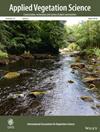Multiple Effects of Capybaras on Vegetation Suggest Impending Impacts of Jaguar Reintroduction
Abstract
Aims
A key challenge in applied vegetation science is understanding the impact of herbivory on plant communities. Herbivores often reduce dominant species' abundance (biomass, cover), making resources available for new species and increasing plant diversity. This understanding is crucial in systems undergoing ecological restoration through trophic rewilding. In Iberá National Park, Argentina, jaguars (Panthera onca) are being reintroduced after a 70-year absence, and it is critical to assess the role of herbivores in shaping plant communities for evaluating future potential trophic cascades. Capybaras (Hydrochoerus hydrochaeris), the park's most abundant herbivore and an important prey for jaguars, likely exert significant pressure on vegetation. This study aims to investigate how capybara herbivory affects vegetation height, biomass, diversity, and composition, providing insights into how jaguar reintroduction might indirectly influence plant communities and restore ecosystem functionality through capybaras' demographic or behavioral responses.
Location
Iberá National Park, Corrientes, Argentina.
Methods
We simulated the absence of capybara foraging pressure by establishing 10 3 m x 3 m herbivore exclosures with adjacent unfenced control plots in the capybara's grazing lawns. Vegetation attributes—height, biomass, plant diversity, and species composition—were monitored over 4 years to assess the impact of capybara exclusion on plant communities.
Results
Excluding capybaras significantly increased vegetation height and biomass, which, in turn, altered plant diversity and species composition. The exclosures' vegetation height and biomass were consistently higher than those in control plots. A decrease in species diversity accompanied this shift, as the abundance of common species declined and the dominance of a few species increased, generating new communities.
Conclusions
Capybaras significantly influence vegetation dynamics, demonstrating their role in shaping plant communities. Excluding capybaras leads to species composition and structural shifts, highlighting herbivory's importance in maintaining ecosystem heterogeneity. These findings provide critical baseline data for understanding the potential indirect impacts of the jaguar's reintroduction on plant communities and ecosystem processes. This study contributes valuable insights into the ecological mechanisms underlying plant–herbivore interactions, which are essential for guiding restoration practices and rewilding strategies.


 求助内容:
求助内容: 应助结果提醒方式:
应助结果提醒方式:


